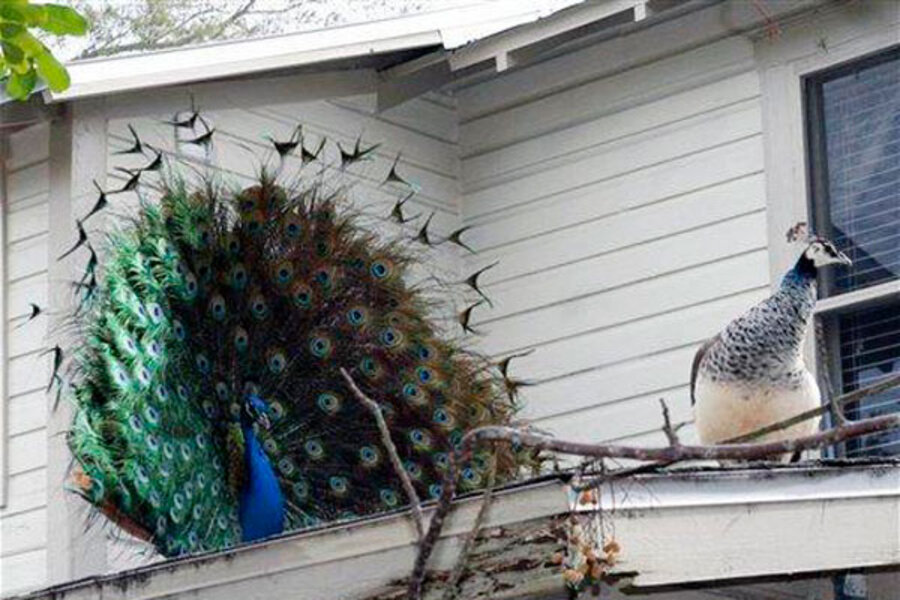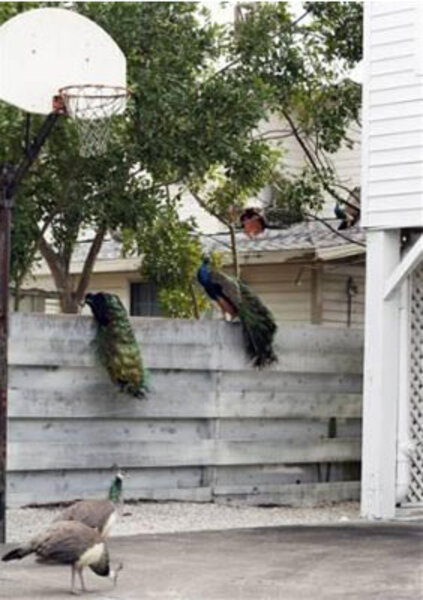Peacocks become a colorful problem in Florida
| LONGBOAT KEY, Fla.
Kip O'Neill worried that peacocks would ruin her family's Christmas.
Her Gulf coast neighborhood is overrun with them: large, regal, noisy, messy birds. Some mornings, Ms. O'Neill finds 30 of them on her roof.
They squawk. They invade yards. They damage cars.
O'Neill said the pesky fowl have pecked her Lexus so much it had to be repainted — twice.
"They poop all in my pool and on my porch," O'Neill said, as two birds wandered onto her front lawn. "They are so destructive and noisy."
The Longboat Key flock, at least 80 birds strong, attacks dark-colored cars because they see their reflection and think it's another bird.
Because of repeated complaints from people like O'Neill, officials on this Florida island have started trapping and moving the colorful birds. They're planning another roundup in the next month to cull the population.
On a recent day, about two dozen peafowl — that's the word for both male and female birds — lazed in a driveway and on a fence of a large home. One male bird displayed his plumage in the sun atop a roof.
"I don't hate the birds, but I know 80 is too many for a tiny village," said Michael Drake, president of the homeowners' association on the section of Longboat Key that is plagued by the peacocks. There are about 200 homes on that part of the island.
Mr. Drake was the one to push for the removal. He describes in great detail how he lays out corn for the birds over the course of a few weeks so they "get to know" him. Then, one day, he throws the corn in his garage so he can trap the birds inside until a critter control company can come to pick them up. The neighborhood association gets reimbursed by local governments for the expense.
"They don't kill the birds," he added. "They bring them to farms. Farmers love them because they eat insects."
The island has to continually remove the birds because they reproduce so frequently. A peahen can lay five or more eggs at a time, and without any natural predators the population grows rapidly. It costs taxpayers some $2,500 a year to relocate the peacocks from Longboat Key.
Peacocks aren't just a Longboat Key issue; communities from Coconut Grove in South Florida to Plant City to Cape Canaveral have grappled with how to deal with the noisy, nonnative birds. Cities in California and Texas have also reported problems with peafowl.
Earlier this year, a Hawaii woman admitted she became so enraged with the birds' constant squawking that she clubbed one to death with a baseball bat. She was later arrested on animal cruelty charges.
"The basic solution to peafowl is that you've got three choices," said Dennis Fett, an Iowa peafowl farmer who often helps communities deal with the birds. "You either learn to live with them, capture them out of existence, or move."
But not everyone wants to see them go — in part, because they are so beautiful and they are also symbols of a laid-back Florida lifestyle.
"I just can't see not living with the world God gave us," said Pat Herrnann, who lives across the street from O'Neill. It makes for some interesting neighborly discussions.
After tourists repeatedly stopped and tossed bread to the vagrant fowl, O'Neill put a big sign on her lawn that said, "Don't Feed the Peacocks."
The sign was stolen, and Ms. Herrnann put up a sign of her own: "Peacocks Welcome!"
One of the last times Drake rounded up some of the birds, a neighbor called police, enraged that he was removing them.
Sighed Drake: "I hate that this issue pits neighbor against neighbor."
The Florida Fish and Wildlife Conservation Commission said it receives dozens of calls from angry residents about peacocks across the state. But the state considers them domestic birds, like chickens, and not wild birds. So officials don't deal with them.
But commission spokesman Gary Morse said it's one more example of a nonnative species invading Florida. Many of the peacocks were once pets that grew too big, or escapees from roadside zoos, or on the lam from farms.
"It's no different than releasing Burmese pythons," he said, citing another invasive species that's overtaken parts of Florida.
Mr. Morse said the birds can be aggressive and messy and can carry diseases.
"The average Florida neighborhood is not a good place for a peacock," he said. "Regardless of how beloved they are by residents."
Editor’s note: The Monitor's Environment section has a new URL. And there's a new URL for its Bright Green blog. We hope you'll bookmark these and visit often.






